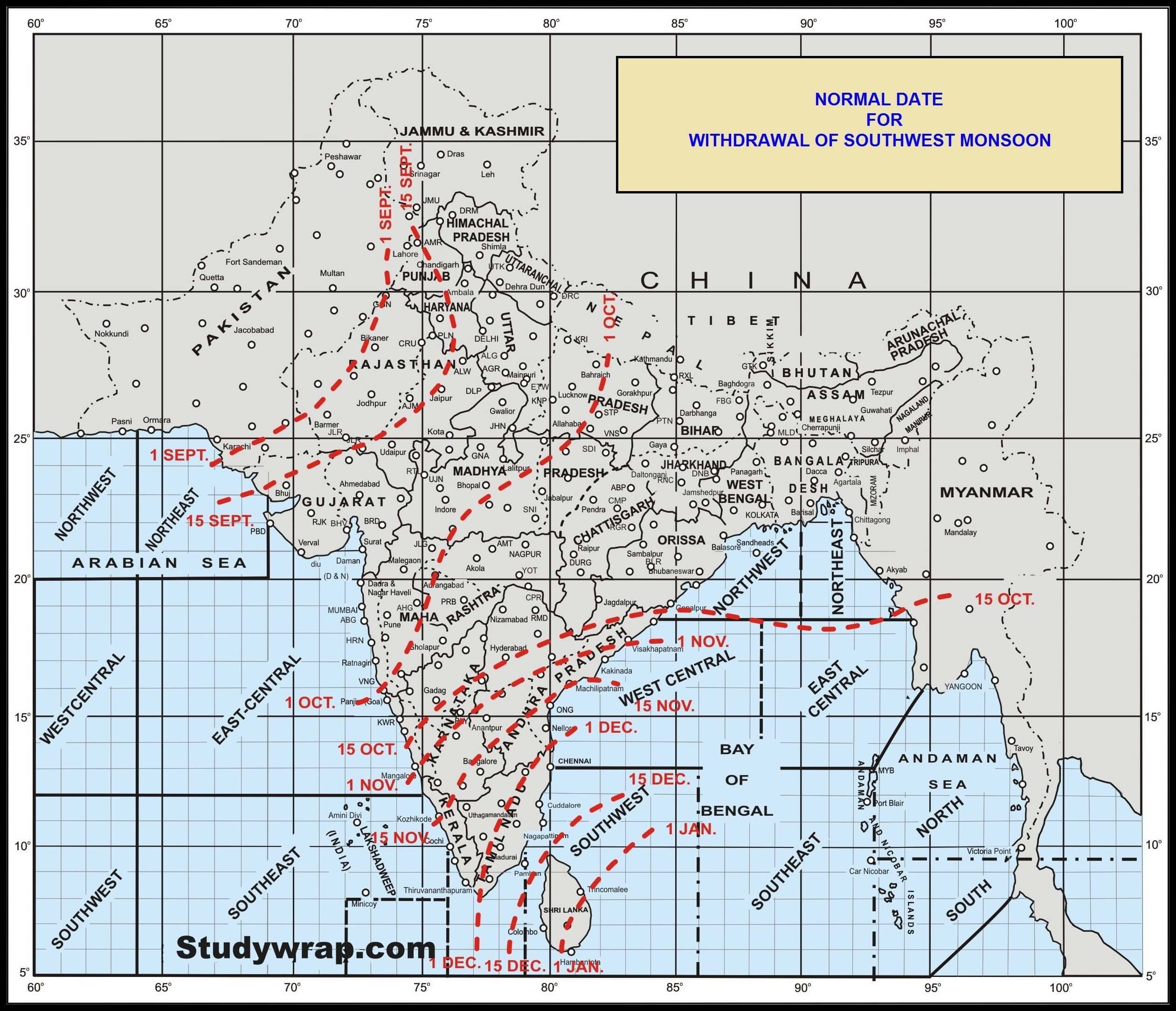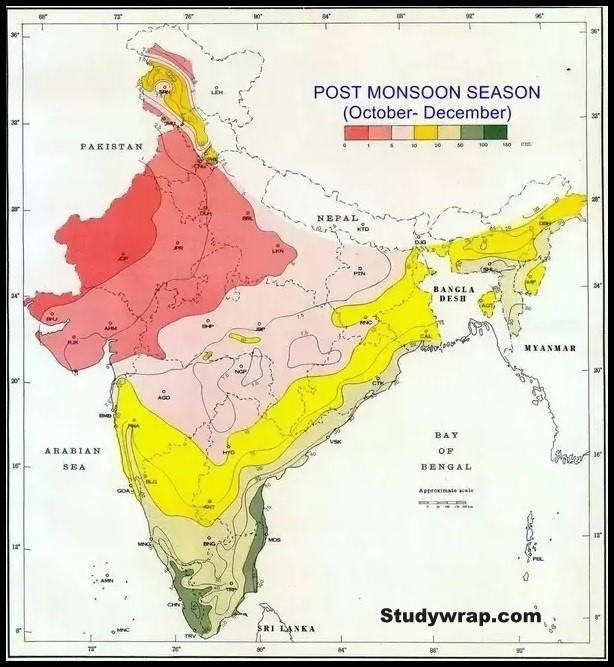Geography
The Indian Climate – Retreating Monsoon Season of India
Indian Climate – Seasons
Table of Contents
-
- The cold weather season or winter season,
- The hot weather season or summer season,
- The south-west monsoon season or Rainy season, and
- The season of the retreating monsoon or cool season.
The Cool Season – Retreating Monsoon Season of India
- Starts with the beginning of the withdrawal of southwest monsoon continues from middle of September upto November. The months of October-November form a period of transition from the hot rainy season to the dry winter conditions.
- The monsoons withdraw from the extreme north-west end of the country in September, from the peninsula by October and from the extreme south-eastern tip by December.
- The withdrawal of the south-west monsoon and the onset of north-east monsoon are both gradual phenomenon. They take place almost at the same time and tend to merge. This explains the popularity of the phrase “Retreating Monsoon”.
- Unlike the sudden burst of the advancing monsoons, the withdrawal is rather gradual and takes about three months.
Season of Retreating Monsoon
-
- The retreat takes place due to the weakening of the low-pressure area over the north-western parts of India and thus a gradual transition of ITCZ towards the south. This happens due to:
-
- The apparent shift of sun towards the equator
- Reduction in temperature due to widespread rains.
-
- Consequently, the air pressure starts decreasing. Such changes in the atmospheric pressure cause the south-west monsoons to withdraw.
- The Retreat of Monsoons is a process much slower than its arrival. It is a gradual change of comparative pressure positions, thus gradually weakening and reducing the area of coverage and influence.
- The retreat takes place due to the weakening of the low-pressure area over the north-western parts of India and thus a gradual transition of ITCZ towards the south. This happens due to:
The retreat –
-
- The south-west monsoons start retreating in the second week of September from Punjab in North-West India. Thus these winds withdraw earlier from the regions they reached the last.
- The monsoon retreats from the western Rajasthan by the first week of September. It withdraws from Rajasthan, Gujarat, Western Ganga plain and the Central Highlands by the end of the month.
- By the beginning of October, the low pressure covers northern parts of the Bay of Bengal and by early November, it moves over Karnataka and Tamil Nadu.
- By the middle of December, the centre of low pressure is completely removed from the Peninsula.
1. Temperature in Retreating Monsoon Season of India
-
- This season is marked by clear skies and a rise in temperature. The land is still moist. Owing to the conditions of high temperatures (around 25°C) and humidity, the weather becomes rather oppressive and unbearable. This is commonly known as the ‘October heat’ or ‘Kwar ki Umas’.
- In the second half of October, the mercury begins to fall rapidly, particularly in northern India. This continuous decrease in temperature after mid-October helps winter to set in by November or Early December.
- The diurnal range of temperature increases due to lack of cloud cover.
2. Pressure and Winds
-
- As the monsoons retreat, the monsoon trough weakens and gradually shifts southward. Consequently the pressure gradient is low.
- Unlike south-west monsoon, the onset of the north monsoon is not clearly defined.
- The direction of winds over large parts of the country is influenced by the local pressure conditions.
- By and large, the topography of the region influences the wind direction:
-
- The winds are westerly or north-westerly down the Ganga Valley.
- They become northerly in the Ganga-Brahmaputra delta.
- Free from the influence of topography, they are clearly north-easterly over the Bay of Bengal (thus the name North-East monsoon).
-
Cyclones in the Season
-
-
- Most severe and devastating tropical cyclones originate in the Indian seas especially in the Bay of Bengal.
- The low-pressure area lying over north-west India is transferred to the middle of Bay of Bengal by the end of October. As a result of these unstable conditions, severe cyclonic storms originate in this region.
- Highest frequency of the cyclones is in the month of October and the first half of November.
- More cyclones are born in October and then in November and more cyclones originate in the Bay of Bengal than in the Arabian Sea.
- In October, the Cyclones of the Bay of Bengal originate between 8°N and 14°N.
- Initially they move in a west or north-westerly direction, but many of them later recurve and move towards the north-east.
- Near 55 % of the Bay storms cross or affect the Indian coast.
- A bulk of the rainfall of the Caromandel coast is derived from these depressions and cyclones.
- The area’s most vulnerable to these storms include the coastal belts of Tamil Nadu, Andhra Pradesh, Odisha and West Bengal. The thickly populated deltas of the Godavari, Krishna and Kaveri are their preferred targets. Every year cyclones bring disaster here. A few cyclonic storms also strike the coast of West Bengal, Bangladesh and Myanmar.
- Many of the cyclones which strike the eastern coast of India, south of 15°N latitude cross the southern Peninsula and enter Arabian Sea. During this process, they may weaken, but on re-entry over the Arabian Sea they intensify into cyclonic storms.
- The storms of Arabian Sea originate between 12°N and 17°N latitudes in October and between 8° N and 13° N latitudes in November.
- Generally they move away from the coast in a north-westerly direction. But about 25% of them later recurve northeast and strike the Maharashtra or Gujarat coast.
- In north-west India the western disturbances produce clouding and light rainfall in the otherwise fine weather.
- The precipitation is in the form of snow in higher reaches of Jammu and Kashmir, Himachal Pradesh and in Kumaon Hills.
-
3. Precipitation in Retreating Monsoon Season of India
-
- Winter monsoons do not cause rainfall as they move from land to the sea. It is because:
-
- They have little humidity; and
- Due to anti-cyclonic circulation on land, the possibility of rainfall from them reduces.
-
- The humidity and cloud cover are much reduced with the retreat of the south-west monsoons and most parts of the country remain without much rainfall.
- October-November is the main rainy season in Tamil Nadu and adjoining areas of Andhra Pradesh to the south of the Krishna delta as well as a secondary rainy period for Kerala.
- Central parts of India and northern parts of southern Peninsula also get winter rainfall occasionally.
- The retreating monsoons absorb moisture while passing over the Bay of Bengal and cause this rainfall.
- Arunachal Pradesh and Assam in the north-eastern parts of India also have rains between 25 mm and 50 mm during these winter months.
- Winter monsoons do not cause rainfall as they move from land to the sea. It is because:
Annual Rainfall
(South West Monsoons + Retreating Monsoons)
- The average annual rainfall of India is about 118 cm but with large spatial and temporal variations.
- The distribution of rainfall in India is highly uneven. Its distribution is largely controlled by the nearness of the sea and orographic features. The average annual rainfall in India is shown in the following map. Notice that the regional variations in the distribution of rainfall over India are quite pronounced.
a. Areas of very high rainfall
-
- Areas receiving an annual rainfall of 200 cm and above.
- These include western side of Western Ghats and western coastal plains [Thiruvananthapuram in the south to Mumbai in the north].
- The average annual rainfall in this belt is 200-400 cm.
- Assam, Nagaland, Meghalaya, Mizoram, Arunachal Pradesh, Sikkim, parts of Manipur, Tripura and north-eastern tip of West Bengal also receive 200 cm or more, with isolated pockets receiving over 400 cm.
- Meghalaya (the abode of clouds) is the wettest part of the country with Mawsynram and Cherrapunji getting 1,221 and 1,102 cm of annual rainfall respectively.
b. Areas of high rainfall
-
- 100-200 cm annual rainfall.
- Eastern slopes of the Western Ghats, major part of the northern plain, Odisha, Madhya Pradesh, Andhra Pradesh and Tamil Nadu.
- Isohyet (the line joining places of equal rainfall) of 100 cm runs southward from Gujarat coast roughly parallel to the crest of the Western Ghats upto Kanyakumari.
- In north, Southern Jammu and Kashmir, Himachal Pradesh and northern Uttar Pradesh fall in this Area.
c. Areas of low rainfall
-
- 50-100 cm annual rainfall.
- Large parts of Gujarat, Maharashtra. western Madhya Pradesh, Andhra Pradesh, Karnataka, eastern Rajasthan, Punjab, Haryana and parts of Uttar Pradesh.
d. Areas of very low rainfall
-
- These are desert and semi-desert areas receiving less than 50 cm of annual rainfall.
- They include large areas of western Rajasthan, Kachchh and most of Ladakh region of Jammu and Kashmir.
Variability
-
- The rainfall in India is highly variable. The actual rainfall of a place in a year deviates from the average rainfall by 10-60%.
- The variability of rainfall is computed with the help of the following formula:
|
Coefficient of Variability (CV) = (Standard Deviation÷ Mean) × 100 |
-
- It indicates the amount of fluctuation in rainfall recorded over a long period of time from the mean value.
- It ranges between 15 % and 35 % for the country as a whole.
- Variability is highest where the amount of rainfall is lowest.
- The regions of inadequate rainfall are also the regions with the highest variability of rainfall.
- The variability of rainfall has a significant role in the agricultural operations and other economic activities of a country. The areas showing high variability of rainfall have a chronic deficiency of water.
So, this is all about the Climate in Retreating Monsoon Season of India.
In the next post (Click here), we will study about the Climatic Regions of India.






Great Notes with clear to the point understanding thanks